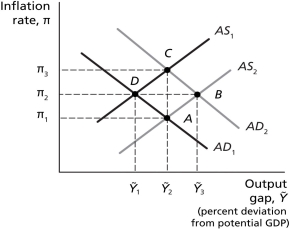Multiple Choice
Figure 14.3

-Refer to Figure 14.3.uppose the economy is initially at long-run equilibrium and the Bank of Canada increases the target inflation rate,and to hit this rate,it must reduce the real interest rate.The economy then reaches a new,short-run equilibrium point.Assuming expectations are adaptive,the next movement will result in the inflation rate
A) rising to π₂, the new long-run inflation rate.
B) falling to π₂, the new long-run inflation rate.
C) rising to π₃, the new long-run inflation rate.
D) falling back to π₁, the original long-run inflation rate.
Correct Answer:

Verified
Correct Answer:
Verified
Q16: The Fed (which is the central bank
Q17: What is stagflation,and how does it occur?
Q18: If a policy change by the Bank
Q19: For each of the following scenarios,state the
Q20: Figure 14.1<br> <img src="https://d2lvgg3v3hfg70.cloudfront.net/TB4177/.jpg" alt="Figure 14.1
Q22: Shifts in the IS curve _ the
Q23: Assume the economy is initially in equilibrium
Q24: Figure 14.3<br> <img src="https://d2lvgg3v3hfg70.cloudfront.net/TB4177/.jpg" alt="Figure 14.3
Q25: Assume the economy is initially in equilibrium
Q26: Figure 14.1<br> <img src="https://d2lvgg3v3hfg70.cloudfront.net/TB4177/.jpg" alt="Figure 14.1